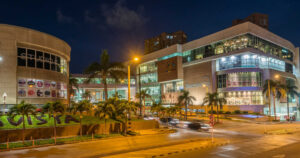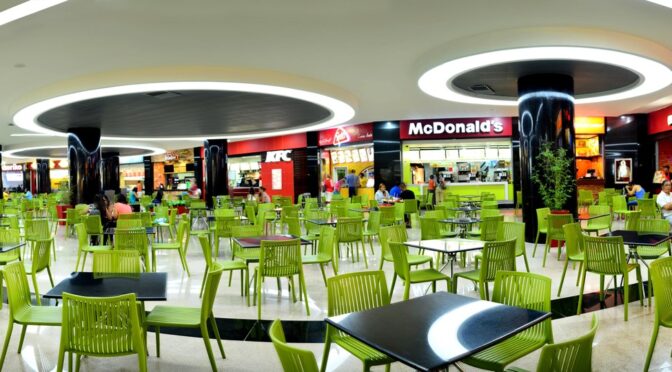Latin American malls emulate western culture in a new form of placemaking Definition: Evaluating the methods and purpose of development for people and place on a hyper-local scale.
By Natalie Raper
Introduction
Malls in the United States are in sharp decline due to the growth of online shopping. However, across Latin America, malls are thriving. In Barranquilla, Colombia, a mall can be found every few blocks. Referred to as ‘el mall’, they are a source of pride in most communities. Malls are often anchored by grocery stores and serve as social gathering spaces, which help integrate them into the immediate neighborhood fabric. However, these extravagant malls are also disrupting the social patterns of these same communities by displacing lower income residents and shifting social spaces from the traditional main plazas found throughout Latin America to malls. The construction of malls provides an opportunity for developers to make these communities more prestigious, which makes these areas of the city more exclusive to those displaced under neoliberal practices while emulating western development patterns and status symbols.
Analysis
The Buenavista mall in Barranquilla opened in 2001 and has since been connected with a skybridge to a second mall, Buenavista II, while a third complex is under construction across the street. In his 2015 article (pre-Buenavista II), Florian Koch called Buenavista a defining project for the city of Barranquilla and the coastal region as a whole. Buenavista’s sheer size dwarfed other similar malls in the region and served as a catalyst for development in the area. Labeled as the “new Barranquilla”, the development that followed the construction of Buenavista included gated communities, larger lots, and upscale commercial developments (Koch, 2015 pp. 411).
The mall and the development around it is reminiscent of similar mall areas in the United States. Stores inside the mall feature English names like ‘Toy Smart’ and t-shirts with English slogans are displayed inside the storefronts to entice shoppers to stop by. The two four-story malls feature high-end brands mixed in with neighborhood amenities like banks and grocery stores. In another nod to western culture, the word “mall” itself is adopted from English. Thus these malls are created to mimic western culture through its globalized placemaking techniques. As discussed by Ong (2011), commercial and residential development around the world often emulates western culture, and, as seen so prominently in the case of the Bahria Town development in Karachi, Pakistan, such developments often feature copies of different global landmarks (Shackle, 2019) to elevate their status. Both the Colombian malls as well as the global landmarks built in Bahria Town serve as status symbols to suggest wealth and prestige in a mirror image of western culture. This is a process that Ong (2011 pp.12) calls worlding, wherein “projects remap relationships and power at different scales and localities” through a process of emergence into a form of globalized identity.
Additionally, the popularity of malls throughout Latin America has also shifted the primary social space within communities from the traditional plaza to the enclosed space of the mall. Friedmann (2010) suggests that gathering places are essential to placemaking for any community, but in the rush to compete with other cities, mall developments are pushed through without regard to their potential impacts on established social practices and communities being displaced. Shamsuddin (2008) argues that place attachment contributes to an overall sense of place and should be considered during redevelopment. However, new mall developments are often incompatible with the existing character of place, leading to a weakening sense of place identity.
As Gaffney suggests, leaders see sports mega events as “an opportunity to project a city to a global audience” (2014 pp. 2). To achieve their goal, the city must undergo a series of physical, societal, and cultural changes, which are introduced through neoliberal governance policies under the premise of transforming the city for the better. The same process happens with the development of these malls, just on a smaller scale. Rather than elevating an entire city to attract a global audience, the goal is to transform the city into a regional attraction through mall development. Ultimately, through worlding strategies, the malls become exclusionary to the people they displace, while sports mega events exclude people during its construction. At the same time, both the mall and the mega events have the same goal of ‘cleaning up’ the area where they are located.
Implications
While each mall development only impacts a small part of the city, this is happening across Latin America at a rapid pace. The phenomenon of emulating western culture through development is not new, nor does it happen exclusively in Latin America, and nor does it occur solely through the development of malls. However, this process reveals the continued prioritization and preference for western culture to represent wealth, which in turn reinforces the hierarchical and binary perception that western culture is worth more than other cultures. By drawing on western discourse and symbols of wealth, mall development in Latin America serves to further reinforce the development standards of western culture (Escobar, 2012) and conform with western ideals of normality (Kamete, 2009).
Additionally, the development practices used to create these malls are also changing the culture of these spaces. As detailed by Gaffney, the developments following this pattern often exasperate income inequity and result in massive displacement of lower income residents while simultaneously creating exclusive areas for the wealthier (2014). As is evidenced by the high-end retail offerings in the mall as well as the surrounding development patterns, the wealthy are the primary target for this development, thus excluding people who can no longer afford to frequent these spaces. Revitalization projects in urban places created under neoliberal practices therefore obscure growing class inequities (Galvis, 2017). To contend with the social impacts of these neoliberal mall developments, it is important to consider people’s stories and social connections (Friedmann 2010) and thus revitalize the traditional place making in these communities.

Buenavista I and II. See Source Here.

Food court in Buenavista. See Source Here.

Plaza de San Nicolas- an example of a traditional plaza. See Source Here.
